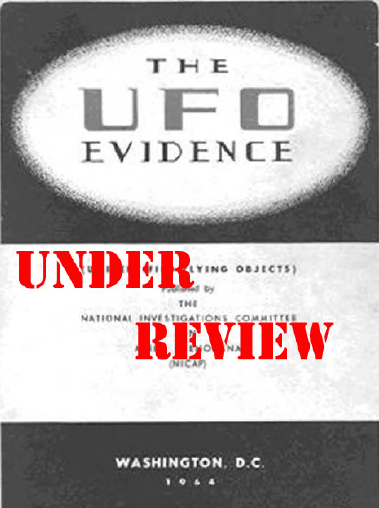
November 5 1957: The USCGC Sebago sighting
The chronology lists this case as:
November 5, 1957--Gulf of Mexico, o New Orleans. Coast Guard cutter Sebago repeatedly tracked UFO on radar, once saw planet-like speeding light. About same time, airman at Keesler AFB, Miss., saw elliptical UFO accelerate rapidly and disappear in clouds. [VIII]1
Section VII is an extensive account, which lists NICAP’s version of what happened:
November 5, 1957; Gulf of Mexico
Just after 5:00 a.m. the U S. Coast Guard Cutter Sebago was about 200 miles south of the Mississippi delta. At 5:10 the bridge radar suddenly showed an unidenti ed target at 246 degrees true, moving N to S, range 12,000 yards (almost 7 miles). On duty were Ensign Wayne Schotley, deck o cer, Lt. (j.g.) Donald Schaefer, rst class quartermaster Kenneth Smith, and radioman Thomas Kirk.
Interviewed in New Orleans, Ensign Schotley was asked how good the radar target was.
Schotley: “The ship’s combat information center con rmed the sighting. At that point it was reported falling astern rapidly. It was a good pip target.. It was a very strong contact, considered good.”
Cmdr. James N. Schrader, spokesman in New Orleans, said that at one point “in two minutes it went 33 miles straight away from the ship.” (About 1020 mph.)
At 5:14 contact was lost.
At 5:16 contact was regained, object about 22 miles north.
At 5:18 object faded o radar screen, range about 55 miles.
At 5:20 contact regained, object appeared stationary, seven miles due north.
About this time, A/1C William J. Mey, an Electronics technician at Keesler AFB, Mississippi (about 320 miles to the north on the Gulf Coast) spotted an elliptical UFO. In his signed report to NICAP, A/1C Mey gives the time as approximately 5:20 a.m. Looking south, he saw the UFO approach on a northerly course at about the speed of a propeller airliner, then accelerate rapidly and disappear into some clouds.
This suggests that more than one UFO may have been operating in the area,,. and that the Sebago’s radar may have tracked more than one of them. A/1C Mey’s report is fairly consistent with the 5:18 radar report of the UFO headed north at over 1000 mph. If Mey actually saw the UFO at 5:28, it would have averaged about 1590 mph., from the time it faded from the Sebago’s radar screen. If he saw it precisely at 5:20 a.m., it would have had to accelerate to nearly 8000 mph. to cover the distance in that time).
At 5:21 the Sebago regained radar contact, and also saw the UFO visually for 3-5 seconds as a brilliant white object with no distinguish- able shape. It was at a bearing of 270 degrees true (west), elevation about 31 degrees, moving horizontally from south to north. (A navi- gator obtained the elevation by noting a star at the same angle and taking a sextant reading of it). The UFO nally entered a cloud bank and disappeared.
At 5:37 the cutter reported its last radar contact with the object, about 175 miles to the north, traveling about 660 mph.2 The UFO investigator of January 1958 gave this description:
One of the most impressive slghtlngs came from the Coast Guard, which considered it so important that a special press conference was held at its New Orleans o ce.
At 5:10 a.m. Tuesday morning in the Gulf of Mexico radar men on the Coast Guard cutter Sebago had picked up a strange ying object. According to Cdr. C.H. Waring, CO of the Sebago, the blips were very strong, indicating that the object was solid, At 5:21 a.m., after the UFO had been tracked maneuvering in concentric circles about the Sebago, the object glowing brightly was seen For three seconds by Four men on deck: Lt. Donald Schaefer, Ensign Wayne 5chotIey, Quartermaster Kenneth Smith and Seaman-radloman Thomas Kirk. The object was moving horizontally at very high speed. The men could see no visible means of propulsion nor any vapor trail. During its maneuvers around the Sebago the unknown object at times reached a speed of almost 1000 mph. Once, brie y, it appeared to be stationary seven miles north of the vessel.
The last radar contact showed it to be 175 miles north heading towards Louisiana. It had covered this distance in 17 minutes as proved by the Sebogo’s o cial log.3
While there is no disputing the events happened, NICAP appears to have drawn the wrong conclusion that it was a single craft that circled the Sebago. They apparently wrote their account based on reports by the news media, which did not quite accurately report the events.
The Blue Book file
The Blue Book file contains the actual message that was transmitted shortly after the event. It presents a slightly di erent version
0510 CST - Contact at 290 degree true bearing 14 miles distant moving from north to south. No visual or audible contact.
0513 CST - Contact 2 miles distant returned up port side of ship, moving south to north.
0514 CST - Contact lost
0516 CST - Contact regained at 188 degree true bearing. 22 miles distant.
0518 CST - Contact faded at 190 degree true bearing. 55 miles distant.
0520 CST - Contact regained at 350 degree true bearing. 7 miles distant and station- ary.
0521 CST - Visual contact at 270 degree true bearing. 31 degree angle moving in northerly direction 270 to 310 degrees in approximately 3 seconds.
0537 CST - Last contact at 015 degree true bearing. 175 miles distant.4
As usual, Blue Book was criticized for their explanation for what was seen. On No- vember 15th, they stated that some of the radar contacts were probably aircraft and possible spurious radar returns.5 After Blue Book took a closer look, they determined that the radar contacts were false targets and the visual sighting was probably just a meteor.
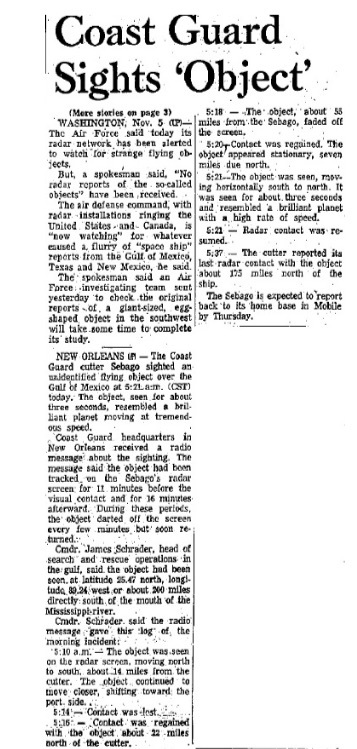
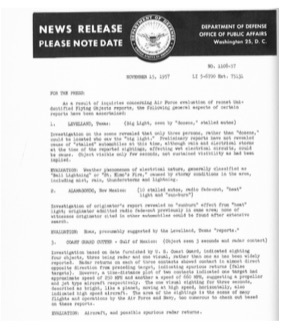
The le also contained a sketch of the radar contacts and track of the Sebago.7 This appears to have been drawn by Captain Gregory. It is somewhat similar to the sketch that Robert Todd received from his FOIA requests in 1975.8 That sketch was made by Command- er Waring, the Commanding O cer of the Sebago.
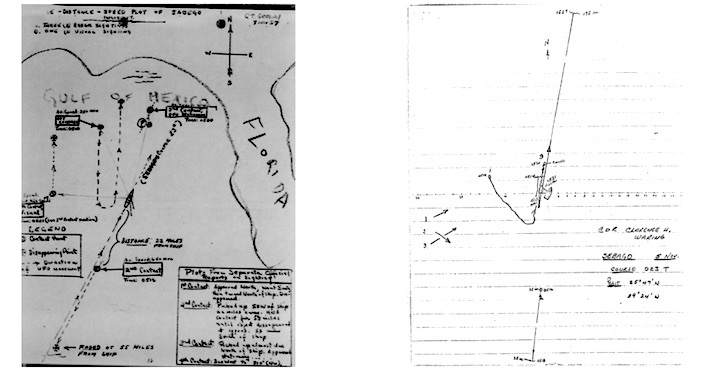
Condon report evaluation
Dr. Gordon Thayer evaluated the Sebago case for the Condon report and drew the following conclusions:
The visual object was described as “like a brilliant planet;” it was undoubtedly a meteor, and in any event obviously was unrelated to radar target number three, the only radar target visible at the same time.
The radar targets were, with the possible exception of the rst one, erratic and unpredictable in their movements. The second and third radar blips appeared suddenly, well within the normal pick-up range of the ship’s radar. These two blips were probably caused by anom- alous propagation. The two Key West pro les, although taken at some distance from the ship’s position, are indicative of rather unusual atmospheric conditions in the area. Indeed, the 1800 LST pro le is probably one of the most unusual radio refractive index pro les that has ever been observed. The atmospheric structure was apparently one of alternating very wet and very dry layers. Patterns of this sort are often very stable in these subtropical latitudes, and tend to extend in rather homogeneous form over large horizontal distances. The ray-tracing of this pro le, Fig. 23a, shows even greater changes in ray curvature. Strong partial re ections should be expected under these conditions.
The rst radar target behaved generally like an aircraft, and the AF investigators were of the opinion that it was an aircraft, probably from Eglin AFB to the north.
In summary, the weight of evidence points toward anomalous propagation as the cause of the radar echoes, the rst possibly being an aircraft. The visual object was apparently a meteor.9
One problem I have with Thayer’s analysis is that he mentions only the 2400Z (1800CST) pro le as being important. The 1200Z (0600CST) readings did not show as strong an inversion as the 1800 pro le but it still was signi cant. Another problem is the read- ings were from Key West roughly 350 miles away. Of course, it is hard to come by any data that was close to the ship. I did a check of the Radiosonde database and found there were readings at 1200Z from Burrwood, LA, Eglin AFB, Florida, and Tampa, Florida.10 These are roughly 275 miles, 350 miles, and 330 miles distant respectively. All of these soundings indicated temperature inversions of some kind between 1 and 2 KM altitude. This data, in conjunction with the Key West readings, indicates that most of the region had temperature inversions that could have produced false radar targets. Thayer seemed to be correct on that point.
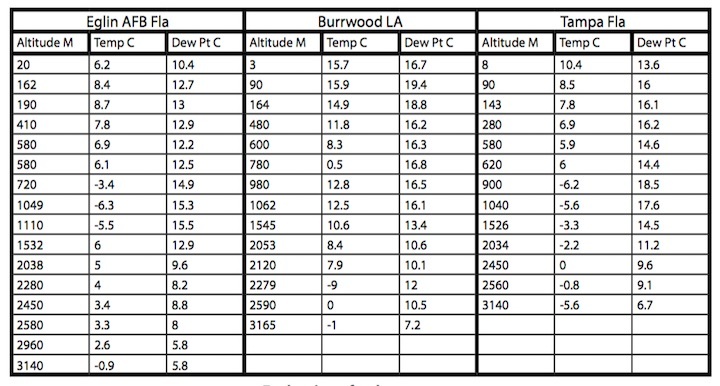
Evaluation of radar contacts
There is little reason to reject the meteor explanation for the visual sighting and the radar contacts do not relate to that event. The three radar contacts need to be separately evaluated.
Radar contact 1
The Contact was rst seen by the radar o the port bow of the ship. It was moving south at a distance of 14 miles and closed to within 2 miles when it turned north. With a 12 mile distance traveled in roughly three minutes, the speed of the object would have been roughly 240 mph. This is well within the speed of a normal aircraft. If it were an aircraft, I suspect it was a Navy patrol plane. The Navy had P2Vs ying from Dallas and Jacksonville Naval Air stations. The actions of the target appear to be the kind of action one would expect from an aircraft investigating a ship. Once they determined what the ship was, they probably returned to their patrol.
Radar contact 2
This contact lasted two minutes and was not related to the rst sighting. Its behavior was very transitory and suggests a false target.
Radar contact 3
This is somewhat confusing and it is not related to the second contact or the visual sighting. It might have been an aircraft or false target. The report states it was lost at 175 miles distance indicates that this contact may, or may not, have been related to the stationary target seen seventeen minutes prior to this.
Solved?
There is no indication that the radar contacts represented “manifestations of extraterrestrial life” as the UFO best evidence doc- ument states. However, there is enough evidence to suggest that the contacts were probably due to anomalous propagation and, possibly, an aircraft. The visual sighting appears to have been nothing more than a bright meteor. While the case cannot be conclusively solved, it certainly is not “best evidence” since there is a viable hypothesis that does not assume the existence of alien spaceships.
Quelle: SUNlite 6/2017
